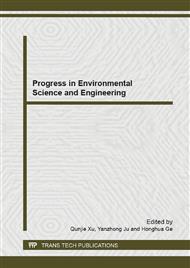[1]
L. J. Puckett: Environ. Sci. Technol. Vol. 29 (1995) 408A-414A
Google Scholar
[2]
K. P. Cantor: Cancer Causes and Control Vol. 8 (1997) 292-308.
Google Scholar
[3]
D. Majumdar and N. Gupta: Indian J. Environ. Health Vol. 42 (1) (2000) 28-39.
Google Scholar
[4]
S. R. Carpenter, N. F. Caraco, D. L. Correll, R. W. Howarth, A. N. Sharpley and V. H. Smith: Ecol. Appl. Vol. 8 (1998) 559-568.
Google Scholar
[5]
World Health Organization: Rolling revision of the WHO guidelines for Drinking-water quality, Nitrates and nitrites in drinking water, World health Organization, 2004.
DOI: 10.1002/9780470172971.app2
Google Scholar
[6]
S. Samatya, N. Kabay, Ü. Yüksel, M. Rda and M. Yüksel: React. Funct. Polym. Vol. 66 (2006) 1206-1214.
Google Scholar
[7]
Y. Fernández-Nava, E. Maranon, J. Soons and L. Castrillón: Bioresour. Technol. Vol. 99 (2008) 7976-7981.
Google Scholar
[8]
S. Ghafari, M. Hasan and M. K. Aroua: Bioresour. Technol. Vol. 99 (2007) 3965-3974.
Google Scholar
[9]
M. Li, C. P. Feng, Z. Y. Zhang, X. H. Lei, R. Z. Chen and N. Sugiura: J. Hazard. Mater. Vol. 171 (2009) 724-730.
Google Scholar
[10]
M. Li, C. P. Feng, Z. Y. Zhang and N. Sugiura: Electrochim. Acta Vol. 54 (2009) 4600-4606.
Google Scholar
[11]
D. Reyter, D. Bélanger and L. Roué: Electrochim. Acta Vol. 53 (2008) 5977-5984.
Google Scholar
[12]
H. Li, J. Q. Chambers and D. T. Hobbs: J. Appl. Electrochem. Vol. 18 (1988) 454-458.
Google Scholar
[13]
A. C. A. De Vooys, R. A. Van Santen and J. A. R. Van Veen: J. Mol. Catal. A Chem. Vol. 154 (2000)203-215.
Google Scholar
[14]
K. W. Kim, Y. J. Kim, I. T. Kim, G. I. Park and E. H. Lee: Water Res. Vol. 40 (2006) 1431-1441.
Google Scholar
[15]
J. Chen, H. Shi and J. Lu: J. Appl. Electrochem. Vol. 37 (2007) 1137–1144.
Google Scholar
[16]
K. W. Kim, Y. J. Kim, I. T. Kim, G. I. Park and E. H. Lee: Electrochim. Acta Vol. 50 (2005) 4356-4364.
Google Scholar
[17]
L. Szpyrkowicz, S. Daniele, M. Radaelli and S. Specchia: Appl. Catal. B: Environ. Vol. 66 (2006) 40–50.
Google Scholar
[18]
D. Reyter, D. Bélanger and L. Roué: Water Res. Vol. 44 (2010) 1918-1926.
Google Scholar
[19]
APHA, AWWA, WPCF: Standard methods for the examination of water and wastewater, American Public Henlth Associction, Washington, DC, USA, 1998.
Google Scholar
[20]
S. H. Lin and C. L. Wu: Water Res. Vol. 30 (1996), 715-721.
Google Scholar
[21]
A. G. Vlyssides, P. K. Karlis, N. Rori and A. A. Zorpas:J. Hazard. Mater. Vol. 95 (2002) 215-226.
Google Scholar
[22]
G. C. C. Yang and H. L. Lee: Water Res. Vol. 39 (2005) 884-894.
Google Scholar
[23]
C. P. Huang, H. W. Wang and P. C. Chiu: Water Res. Vol. 32 (1998) 2257-2264.
Google Scholar
[24]
G. E. Badea: Electrochim. Acta Vol. 54 (2009) 996-1001.
Google Scholar
[25]
WHO, Water Sanitation and Health (WSH): Guidelines for Drinking-Water Quality, 3 rd ed World Health Organization, Geneva, Switzerland, 2004.
Google Scholar


